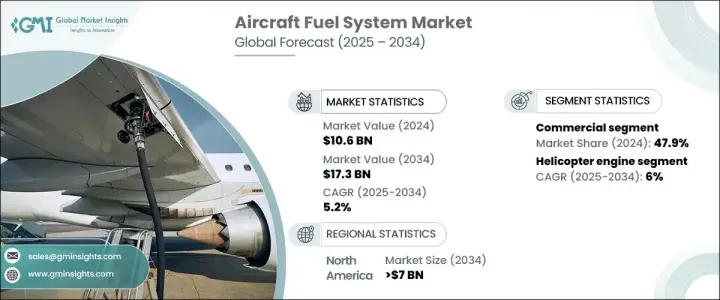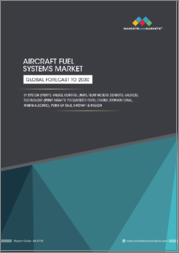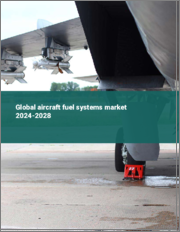
|
시장보고서
상품코드
1685085
항공기 연료 시스템 시장 기회, 성장 촉진 요인, 산업 동향 분석, 예측(2025-2034년)Aircraft Fuel System Market Opportunity, Growth Drivers, Industry Trend Analysis, and Forecast 2025 - 2034 |
||||||
세계 항공기 연료 시스템 시장은 2024년에 106억 달러에 이르렀고, 2025년부터 2034년까지 연평균 복합 성장률(CAGR) 5.2%로 성장할 것으로 예상됩니다.
이 상승 궤도는 항공 산업이 연료 효율, 안전성, 지속가능성을 중시하게 된 것이 배경에 있습니다. 지속 가능한 항공 연료(SAF)와 수소와 같은 저탄소 대체 연료를 지원할 수 있는 첨단 연료 시스템으로의 전환은 상황을 변화시키고 있습니다. 항공사, 정부 및 업계 이해관계자들은 엄격한 배출규제를 충족하고 야심적인 환경 목표를 달성하기 위해 혁신적인 기술에 많은 투자를 하고 있습니다.

세계 항공 여행 증가, 추진 시스템의 진보, 항공기 구조에서 경량 재료의 사용 증가는 연료 효율적인 시스템 수요를 더욱 밀어 올리고 있습니다. 또한 디지털 감시 툴과 예지 보전 기능의 통합으로 연료 관리가 보다 뛰어나 운영 비용 절감과 항공기 성능 향상을 실현하고 있습니다. 이러한 동향은 항공우주의 지속가능성을 추진하는데 있어서 연료시스템이 매우 중요한 역할을 하는 미래를 형성하고 있습니다.
| 시장 범위 | |
|---|---|
| 시작 연도 | 2024년 |
| 예측 연도 | 2025-2034년 |
| 시작 금액 | 106억 달러 |
| 예측 금액 | 173억 달러 |
| CAGR | 5.2% |
용도별로는 민간, 군사, UAV의 각 부문으로 나뉘어 2024년 시장 점유율은 민간 부문이 47.9%를 차지했습니다. 민간항공부문에서는 운항효율의 향상, 배출량의 삭감, 안전성 확보를 실현하는 첨단 연료 시스템의 도입이 크게 추진되고 있습니다. 항공사는 연료비를 절감하면서 환경 목표를 달성하기 위해 하이브리드 추진과 SAF에 대응하는 시스템의 도입을 늘리고 있습니다. 이러한 시스템은 신속한 턴어라운드 시간을 가능하게 하고 엄격한 규제 기준을 준수하도록 설계되었으며 최신 항공기 운항에 필수적입니다. 민간항공이 계속 성장하는 가운데 비용효과와 지속가능성의 균형을 중시한 차세대 연료 시스템의 채용이 가속될 것으로 예상됩니다.
엔진 유형별로 볼 때 시장에는 제트 엔진, 헬리콥터 엔진, 터보프롭 엔진, UAV 엔진이 포함됩니다. 헬리콥터 엔진 분야는 가장 급성장하는 카테고리로 떠오르고 있으며 예측 기간 동안 CAGR은 6%로 예상됩니다. 헬리콥터 엔진용 연료 시스템은 신뢰성과 효율성을 위해 특별히 설계되었으며 회전익 항공기 특정 요구 사항을 충족합니다. 이 시스템은 정밀한 연료 관리, 여과 및 다양한 비행 조건에 대한 적응성을 통해 터빈 엔진의 성능을 최적화합니다. 민간, 군사, 수색 구조 활동으로 헬리콥터의 배치가 증가하고 있기 때문에 중요한 임무를 지원하도록 설계된 선진적이고 연료 효율적인 시스템에 대한 수요가 높아지고 있습니다.
북미는 항공기 연료 시스템 시장을 독점하고 2034년까지 70억 달러의 수익이 예상될 것으로 예상됩니다. 미국이 주도하는 이 지역의 항공 산업은 세계의 지속가능성 목표에 부합하는 연료 시스템의 혁신을 추진하고 있습니다. SAF 적합 기술과 수소 대응 기술에 대한 대규모 투자는 이 지역의 항공 배출 감소에 대한 헌신을 강조합니다. 확립된 항공우주 인프라와 최첨단 기술에 대한 주력으로 북미는 항공기 연료 시스템 시장의 최전선에 위치하고 있습니다.
목차
제1장 조사 방법과 조사 범위
- 시장 범위와 정의
- 기본 추정과 계산
- 예측 계산
- 데이터 소스
제2장 주요 요약
제3장 업계 인사이트
- 생태계 분석
- 밸류체인에 영향을 주는 요인
- 이익률 분석
- 혁신
- 장래의 전망
- 제조업체
- 유통업체
- 공급자의 상황
- 이익률 분석
- 주요 뉴스
- 규제 상황
- 영향요인
- 성장 촉진요인
- 연료 효율이 높은 지속 가능한 항공기 기술에 대한 수요 증가
- 성능과 안전성을 향상시키는 항공기 연료 시스템의 발전
- 첨단 연료 시스템의 필요성을 높이는 항공 수요 증가
- 정부의 규제가 연료 효율과 배출 가스의 기술 혁신을 촉진
- 고급 연료 시스템을 필요로 하는 군용기 및 방위기 증가
- 업계의 잠재적 위험 및 과제
- 첨단 연료 시스템의 개발과 유지에 드는 높은 비용
- 업계의 지속가능성에 영향을 미치는 화석연료를 둘러싼 환경문제
- 성장 촉진요인
- 성장 가능성 분석
- Porter's Five Forces 분석
- PESTEL 분석
제4장 경쟁 구도
- 소개
- 기업 점유율 분석
- 경쟁 포지셔닝 매트릭스
- 전략 전망 매트릭스
제5장 시장 추정 및 예측 : 엔진 유형별, 2021년-2034년
- 주요 동향
- 제트 엔진
- 헬리콥터 엔진
- 터보프롭 엔진
- UAV 엔진
제6장 시장 추정 및 예측 : 컴포넌트별, 2021년-2034년
- 주요 동향
- 배관
- 불활성화 시스템
- 펌프
- 밸브
- 계기
- 연료 제어 모니터 시스템
- 필터
제7장 시장 추정 및 예측 : 기술별, 2021년-2034년
- 주요 동향
- 연료 분사
- 펌프 피드
- 그라비티 피드
제8장 시장 추정 및 예측 : 용도별, 2021년-2034년
- 주요 동향
- 상업
- 군사
- UAV
제9장 시장 추정 및 예측 : 지역별, 2021년-2034년
- 주요 동향
- 북미
- 미국
- 캐나다
- 유럽
- 영국
- 독일
- 프랑스
- 이탈리아
- 스페인
- 러시아
- 아시아태평양
- 중국
- 인도
- 일본
- 한국
- 호주
- 라틴아메리카
- 브라질
- 멕시코
- 중동 및 아프리카
- 남아프리카
- 사우디아라비아
- 아랍에미리트(UAE)
제10장 기업 프로파일
- Collins Aerospace(Raytheon Technologies Corporation)
- Crane Aerospace &Electronics
- Eaton Corporation plc
- GE Aviation
- GKN Aerospace
- Honeywell International Inc.
- Marshall Aerospace and Defence Group
- Meggitt PLC
- Parker Hannifin Corp.
- Robert Bosch GmbH
- Safran SA
- Secondo Mona SpA
- Trelleborg AB
- Triumph Group, Inc.
- Woodward Inc.
The Global Aircraft Fuel System Market reached USD 10.6 billion in 2024 and is projected to expand at a robust CAGR of 5.2% from 2025 to 2034. This upward trajectory is fueled by the aviation industry's heightened focus on fuel efficiency, safety, and sustainability. The shift toward advanced fuel systems capable of supporting low-carbon alternatives, such as Sustainable Aviation Fuel (SAF) and hydrogen, is transforming the landscape. Airlines, governments, and industry stakeholders are heavily investing in innovative technologies to meet stringent emission regulations and achieve ambitious environmental goals.

The rise in global air travel, advancements in propulsion systems, and the increasing use of lightweight materials in aircraft construction are further boosting demand for fuel-efficient systems. Moreover, the integration of digital monitoring tools and predictive maintenance capabilities is enabling better fuel management, reducing operational costs, and enhancing aircraft performance. These trends are shaping a future where fuel systems play a pivotal role in advancing aerospace sustainability.
| Market Scope | |
|---|---|
| Start Year | 2024 |
| Forecast Year | 2025-2034 |
| Start Value | $10.6 billion |
| Forecast Value | $17.3 billion |
| CAGR | 5.2% |
By application, the market is divided into commercial, military, and UAV segments, with the commercial segment capturing 47.9% of the market share in 2024. The commercial aviation sector is driving significant adoption of advanced fuel systems that enhance operational efficiency, reduce emissions, and ensure safety. Airlines are increasingly deploying systems compatible with hybrid propulsion and SAF to meet environmental targets while lowering fuel expenses. These systems are designed to enable faster turnaround times and comply with stringent regulatory standards, making them indispensable for modern fleet operations. As commercial aviation continues to grow, the adoption of next-generation fuel systems is expected to accelerate, with a focus on balancing cost-effectiveness and sustainability.
In terms of engine type, the market includes jet engines, helicopter engines, turboprop engines, and UAV engines. The helicopter engine segment is emerging as the fastest-growing category, anticipated to grow at a CAGR of 6% during the forecast period. Fuel systems for helicopter engines are specifically engineered to deliver reliability and efficiency, catering to the unique requirements of rotary-wing aircraft. These systems optimize turbine engine performance through precise fuel management, filtration, and adaptability to varying flight conditions. The increasing deployment of helicopters across commercial, military, and search-and-rescue operations is amplifying the demand for advanced, fuel-efficient systems designed to support critical missions.
North America is projected to dominate the aircraft fuel system market, with an expected revenue of USD 7 billion by 2034. The region's aviation industry, led by the United States, is driving innovation in fuel systems to align with global sustainability goals. Significant investments in SAF-compatible and hydrogen-ready technologies underscore the region's commitment to reducing aviation emissions. With its well-established aerospace infrastructure and focus on cutting-edge advancements, North America remains at the forefront of the aircraft fuel system market.
Table of Contents
Chapter 1 Methodology & Scope
- 1.1 Market scope & definitions
- 1.2 Base estimates & calculations
- 1.3 Forecast calculations
- 1.4 Data sources
- 1.4.1 Primary
- 1.4.2 Secondary
- 1.4.2.1 Paid sources
- 1.4.2.2 Public sources
Chapter 2 Executive Summary
- 2.1 Industry synopsis, 2021-2034
Chapter 3 Industry Insights
- 3.1 Industry ecosystem analysis
- 3.1.1 Factor affecting the value chain
- 3.1.2 Profit margin analysis
- 3.1.3 Disruptions
- 3.1.4 Future outlook
- 3.1.5 Manufacturers
- 3.1.6 Distributors
- 3.2 Supplier landscape
- 3.3 Profit margin analysis
- 3.4 Key news & initiatives
- 3.5 Regulatory landscape
- 3.6 Impact forces
- 3.6.1 Growth drivers
- 3.6.1.1 Increasing demand for fuel-efficient and sustainable aircraft technologies
- 3.6.1.2 Advancements in aircraft fuel systems for better performance and safety
- 3.6.1.3 Growing air travel demand boosting need for advanced fuel systems
- 3.6.1.4 Government regulations driving innovation in fuel efficiency and emissions
- 3.6.1.5 Rise in military and defense aircraft requiring advanced fuel systems
- 3.6.2 Industry pitfalls & challenges
- 3.6.2.1 High costs of developing and maintaining advanced fuel system
- 3.6.2.2 Environmental concerns around fossil fuels affecting industry sustainability
- 3.6.1 Growth drivers
- 3.7 Growth potential analysis
- 3.8 Porter’s analysis
- 3.9 PESTEL analysis
Chapter 4 Competitive Landscape, 2024
- 4.1 Introduction
- 4.2 Company market share analysis
- 4.3 Competitive positioning matrix
- 4.4 Strategic outlook matrix
Chapter 5 Market Estimates & Forecast, By Engine Type, 2021-2034 (USD Million)
- 5.1 Key trends
- 5.2 Jet engine
- 5.3 Helicopter engine
- 5.4 Turboprop engine
- 5.5 UAV engine
Chapter 6 Market Estimates & Forecast, By Component, 2021-2034 (USD Million)
- 6.1 Key trends
- 6.2 Piping
- 6.3 Inerting systems
- 6.4 Pumps
- 6.5 Valves
- 6.6 Gauges
- 6.7 Fuel control monitoring systems
- 6.8 Filters
Chapter 7 Market Estimates & Forecast, By Technology, 2021-2034 (USD Million)
- 7.1 Key trends
- 7.2 Fuel injection
- 7.3 Pump feed
- 7.4 Gravity feed
Chapter 8 Market Estimates & Forecast, By Application, 2021-2034 (USD Million)
- 8.1 Key trends
- 8.2 Commercial
- 8.3 Military
- 8.4 UAV
Chapter 9 Market Estimates & Forecast, By Region, 2021-2034 (USD Million)
- 9.1 Key trends
- 9.2 North America
- 9.2.1 U.S.
- 9.2.2 Canada
- 9.3 Europe
- 9.3.1 UK
- 9.3.2 Germany
- 9.3.3 France
- 9.3.4 Italy
- 9.3.5 Spain
- 9.3.6 Russia
- 9.4 Asia Pacific
- 9.4.1 China
- 9.4.2 India
- 9.4.3 Japan
- 9.4.4 South Korea
- 9.4.5 Australia
- 9.5 Latin America
- 9.5.1 Brazil
- 9.5.2 Mexico
- 9.6 MEA
- 9.6.1 South Africa
- 9.6.2 Saudi Arabia
- 9.6.3 UAE
Chapter 10 Company Profiles
- 10.1 Collins Aerospace (Raytheon Technologies Corporation)
- 10.2 Crane Aerospace & Electronics
- 10.3 Eaton Corporation plc
- 10.4 GE Aviation
- 10.5 GKN Aerospace
- 10.6 Honeywell International Inc.
- 10.7 Marshall Aerospace and Defence Group
- 10.8 Meggitt PLC
- 10.9 Parker Hannifin Corp.
- 10.10 Robert Bosch GmbH
- 10.11 Safran SA
- 10.12 Secondo Mona S.p.A
- 10.13 Trelleborg AB
- 10.14 Triumph Group, Inc.
- 10.15 Woodward Inc.















